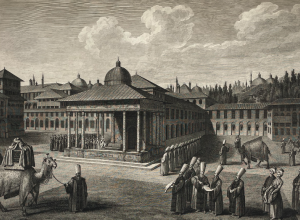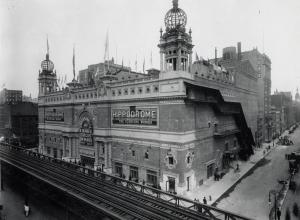September 4, 2012
Chromo-Mania! at the Boston Athenæum
(Boston, Massachusetts, 2012) “Chromo-Mania! The Art of Chromolithography in Boston, 1840-1910,” an exhibition on view in the Norma Jean Calderwood Gallery of the Boston Athenæum September 28, 2012 to January 12, 2013, explores the extraordinary diversity, technical virtuosity, and beauty of chromolithographs produced in Boston. The exhibition and its catalogue will describe how chromolithographs were made and will explore how Boston publishers helped develop this revolutionary new technology that transformed how visual images were created, transmitted, and received.
Organized by Catharina Slautterback, curator of prints & photographs, “Chromo-Mania!” will include over sixty works, ranging from vivid town and city views; to book, periodical, and sheet music illustrations; large-scale advertisements; art reproductions (including works by Asher B. Durand and Winslow Homer); and historical commemorations. The work of such innovative Boston publishers as William Sharp, J. H. Bufford, Louis Prang, and many others will be represented.

Organized by Catharina Slautterback, curator of prints & photographs, “Chromo-Mania!” will include over sixty works, ranging from vivid town and city views; to book, periodical, and sheet music illustrations; large-scale advertisements; art reproductions (including works by Asher B. Durand and Winslow Homer); and historical commemorations. The work of such innovative Boston publishers as William Sharp, J. H. Bufford, Louis Prang, and many others will be represented.

A display of lithographic tools and stones, lent to the exhibition by master printer Carolyn Muskat, and images of a Victorian lithographic studio will explain how the elaborate lithographic process created stunning full-color images long before color photography. Visitors to the show will be able to handle a specially-made facsimile of a proof book, which shows how chromolithographs were printed from as many as fifty separate stone plates. Muskat has also created a chromolithographic work especially for the exhibition, which will display her progressive proofs for the image. An illustrated catalogue, with an historical essay by Catharina Slautterback, will accompany the show.
The works on view will be drawn from the nationally renowned collection of the Boston Athenæum, one of the most extensive of its kind. A small, related exhibition in the Athenæum will display recent chromolithograph acquisitions, dating from the 1850s up to the twenty-first century, including such contemporary works as Beth van Hoesen’s monumental “San Francisco Dahlias” (1995).
An insatiable appetite for chromolithographs
“Chromo-mania” was first coined in the 1860s to ridicule America’s insatiable appetite for chromolithographs, a new technology as ubiquitous and popular as the iPod is today. Chromolithograph publishers soon took up the term as a badge of pride, attesting to the public acclaim their work received.
Lithography (from the Greek for “stone” and “to write”), discovered in the late eighteenth century in Germany, was originally a black-and-white medium. The printing process allows the artist to draw directly on a plate of fine-grained limestone and exploits the chemical properties of oil and water to create an image that appears very close to the original drawing. At first, publishers added colors by hand. Later, lithographs were printed in multiple colors on separate stones by the complex method called chromolithography.
Boston as a center of the American lithograph
Lithography began to take hold in Boston in the 1820s. Pendleton’s Lithography of Boston, one of the first and most important early firms, trained Fitz Henry Lane (also known as Fitz Hugh Lane), Benjamin Champney, and many other artists of their generation in lithographic draftsmanship.
The first American chromolithographs were printed in Boston in the early 1840s. Soon Boston firms like J. H. Bufford & Co. and L. H. Bradford and Company were enjoying enormous commercial success. Some Boston publishers produced fine art reproductions or accurate and detailed scientific illustrations. Others specialized in large-scale, lavish, chromolithographic advertisements, using dozens of separately colored, inked, and printed stones. Many of the examples in the exhibition are virtuosic artistic performances and are flawlessly executed.
Louis Prang’s “empire”
Another Boston printer, the ambitious and shrewd German emigré Louis Prang, built what Slautterback calls “arguably... the most successful chromolithographic empire in the country. His ‘American Chromos’ would re-define the very meaning of chromolithography, alter the course of art education in the country, and, for better or for worse, dictate the aesthetic tastes of two generations of Americans.” After an early success making mostly black-and-white images of the Civil War-- battle scenes, officer’s portraits, sheet music, and maps-- Prang returned to Europe to broaden his knowledge of chromolithography. Later, back in Boston, he had even greater success.
L. Prang & Company billed their “American Chromos” as “fac-similes” or “artistic copies” of works by Winslow Homer, Thomas Moran, and other important artists. They were framed and hung in parlors, bed chambers, dining rooms, churches, schoolrooms, and public buildings across the country.
Using elaborate new techniques, Prang boasted only experts could distinguish his copies from the originals. At a time when public museums and art galleries were rare in the United States, Prang, a former revolutionary in his native Germany, sought to make art accessible to the ordinary citizen, not just the rich. His prints were not only decoration but taught moral lessons as well. To promote his reputation among America’s intellectual and political vanguard, Prang even sent free copies of his Chromos to prominent Abolitionists like Frederick Douglass.
Prang created an Art Education Department within his company to support art education in public schools. The Prang Education Company, established in 1882, became a leading source of texts and art supplies for schools across the country, a legacy of enormous influence that continues to this day. ??
Prang’s technically advanced efforts led to such breathtaking images as the portfolio “The Yellowstone National Park” (1876), with plates after watercolors by Thomas Moran. “[N]o finer specimens of chromo-lthographic work have been produced anywhere,” proclaimed The Times of London of this publication. Prang considered the 116 plates for Oriental Ceramic Art; Illustrated by Examples from the Collection of W.T. Walters (New York, 1897), which took Prang’s craftsmen more than seven years to complete, as his “monument.”
The exhibition includes chromolithographs after Homer and Moran, examples from the Yellowstone portfolio and the “Oriental Ceramic Art,” along with proof sets of the latter that show the elaborate methods used to create them.
A rich legacy of images
Not everyone was impressed by the efforts of Prang and other Boston lithographers to raise color printing to the level of fine art. Chromos, sneered Clarence Cook, art critic of the influential New York Tribune, were like “false diamonds, false hair, false teeth... [with] which homely people try to make themselves look pretty, and succeed in making themselves hideous... We have said the chromo-lithography is not art at all... it is mere mechanic process.”
Prang countered by publishing celebrity testimonials from Henry Wadsworth Longfellow, Harriet Beecher Stowe and others, and by claiming that chromolithographs were a “reproductive” art not intended to be original. Prang’s tremendous business success allowed him to build a large factory in Roxbury, recruit a highly skilled staff. and to use the latest technologies, including the first steam-powered press.
The overwhelming popularity of chromolithographs, and the promotional efforts of Prang and his rivals, including the Forbes Lithographic Manufacturing Company and George H. Walker & Company, meant that Boston printers remained pre-eminent until they were overtaken by such new technologies as photo-lithography, in the twentieth century. The exhibition celebrates their creativity, ingenuity, and legacy.
“Although the medium had been used for commercial purposes from its earliest years...,” writes Slautterback, “many chromolithographs produced in Boston were striking and superbly crafted prints, regardless of whether they were sheet music covers, advertisements, or art reproductions.”
About the Norma Jean Calderwood Gallery:
Located on the first floor of the Boston Athenæum’s National Historic Landmark building at 10½ Beacon Street in the heart of Beacon Hill, Boston, Massachusetts, the Norman Jean Calderwood Gallery is the Athenæum’s main public exhibition space. It is within walking distance of the Government Center and Park Street MBTA stations. Parking is available in a commercial lot across from the building and in the Boston Common Parking Garage, under the Boston Common and accessible from Charles Street.
The Norma Jean Calderwood Gallery is open to the public from 9:00 am to 5:00 pm on Tuesday, Thursday, and Friday; from 9:00 am to 7:30 pm on Monday and Wednesday; and from 9:00 am to 3:30 pm on Saturday. Closed on major holidays. Admission to special exhibitions in the Calderwood Gallery is free to members; $5.00 for non-members. For general information about the Calderwood Gallery and the Boston Athenæum, call 617-227-0270. For reservations for special events requiring reservations, call 617-720-7600. Or visit the Athenæum website at www.bostonathenaeum.org.
The works on view will be drawn from the nationally renowned collection of the Boston Athenæum, one of the most extensive of its kind. A small, related exhibition in the Athenæum will display recent chromolithograph acquisitions, dating from the 1850s up to the twenty-first century, including such contemporary works as Beth van Hoesen’s monumental “San Francisco Dahlias” (1995).
An insatiable appetite for chromolithographs
“Chromo-mania” was first coined in the 1860s to ridicule America’s insatiable appetite for chromolithographs, a new technology as ubiquitous and popular as the iPod is today. Chromolithograph publishers soon took up the term as a badge of pride, attesting to the public acclaim their work received.
Lithography (from the Greek for “stone” and “to write”), discovered in the late eighteenth century in Germany, was originally a black-and-white medium. The printing process allows the artist to draw directly on a plate of fine-grained limestone and exploits the chemical properties of oil and water to create an image that appears very close to the original drawing. At first, publishers added colors by hand. Later, lithographs were printed in multiple colors on separate stones by the complex method called chromolithography.
Boston as a center of the American lithograph
Lithography began to take hold in Boston in the 1820s. Pendleton’s Lithography of Boston, one of the first and most important early firms, trained Fitz Henry Lane (also known as Fitz Hugh Lane), Benjamin Champney, and many other artists of their generation in lithographic draftsmanship.
The first American chromolithographs were printed in Boston in the early 1840s. Soon Boston firms like J. H. Bufford & Co. and L. H. Bradford and Company were enjoying enormous commercial success. Some Boston publishers produced fine art reproductions or accurate and detailed scientific illustrations. Others specialized in large-scale, lavish, chromolithographic advertisements, using dozens of separately colored, inked, and printed stones. Many of the examples in the exhibition are virtuosic artistic performances and are flawlessly executed.
Louis Prang’s “empire”
Another Boston printer, the ambitious and shrewd German emigré Louis Prang, built what Slautterback calls “arguably... the most successful chromolithographic empire in the country. His ‘American Chromos’ would re-define the very meaning of chromolithography, alter the course of art education in the country, and, for better or for worse, dictate the aesthetic tastes of two generations of Americans.” After an early success making mostly black-and-white images of the Civil War-- battle scenes, officer’s portraits, sheet music, and maps-- Prang returned to Europe to broaden his knowledge of chromolithography. Later, back in Boston, he had even greater success.
L. Prang & Company billed their “American Chromos” as “fac-similes” or “artistic copies” of works by Winslow Homer, Thomas Moran, and other important artists. They were framed and hung in parlors, bed chambers, dining rooms, churches, schoolrooms, and public buildings across the country.
Using elaborate new techniques, Prang boasted only experts could distinguish his copies from the originals. At a time when public museums and art galleries were rare in the United States, Prang, a former revolutionary in his native Germany, sought to make art accessible to the ordinary citizen, not just the rich. His prints were not only decoration but taught moral lessons as well. To promote his reputation among America’s intellectual and political vanguard, Prang even sent free copies of his Chromos to prominent Abolitionists like Frederick Douglass.
Prang created an Art Education Department within his company to support art education in public schools. The Prang Education Company, established in 1882, became a leading source of texts and art supplies for schools across the country, a legacy of enormous influence that continues to this day. ??
Prang’s technically advanced efforts led to such breathtaking images as the portfolio “The Yellowstone National Park” (1876), with plates after watercolors by Thomas Moran. “[N]o finer specimens of chromo-lthographic work have been produced anywhere,” proclaimed The Times of London of this publication. Prang considered the 116 plates for Oriental Ceramic Art; Illustrated by Examples from the Collection of W.T. Walters (New York, 1897), which took Prang’s craftsmen more than seven years to complete, as his “monument.”
The exhibition includes chromolithographs after Homer and Moran, examples from the Yellowstone portfolio and the “Oriental Ceramic Art,” along with proof sets of the latter that show the elaborate methods used to create them.
A rich legacy of images
Not everyone was impressed by the efforts of Prang and other Boston lithographers to raise color printing to the level of fine art. Chromos, sneered Clarence Cook, art critic of the influential New York Tribune, were like “false diamonds, false hair, false teeth... [with] which homely people try to make themselves look pretty, and succeed in making themselves hideous... We have said the chromo-lithography is not art at all... it is mere mechanic process.”
Prang countered by publishing celebrity testimonials from Henry Wadsworth Longfellow, Harriet Beecher Stowe and others, and by claiming that chromolithographs were a “reproductive” art not intended to be original. Prang’s tremendous business success allowed him to build a large factory in Roxbury, recruit a highly skilled staff. and to use the latest technologies, including the first steam-powered press.
The overwhelming popularity of chromolithographs, and the promotional efforts of Prang and his rivals, including the Forbes Lithographic Manufacturing Company and George H. Walker & Company, meant that Boston printers remained pre-eminent until they were overtaken by such new technologies as photo-lithography, in the twentieth century. The exhibition celebrates their creativity, ingenuity, and legacy.
“Although the medium had been used for commercial purposes from its earliest years...,” writes Slautterback, “many chromolithographs produced in Boston were striking and superbly crafted prints, regardless of whether they were sheet music covers, advertisements, or art reproductions.”
About the Norma Jean Calderwood Gallery:
Located on the first floor of the Boston Athenæum’s National Historic Landmark building at 10½ Beacon Street in the heart of Beacon Hill, Boston, Massachusetts, the Norman Jean Calderwood Gallery is the Athenæum’s main public exhibition space. It is within walking distance of the Government Center and Park Street MBTA stations. Parking is available in a commercial lot across from the building and in the Boston Common Parking Garage, under the Boston Common and accessible from Charles Street.
The Norma Jean Calderwood Gallery is open to the public from 9:00 am to 5:00 pm on Tuesday, Thursday, and Friday; from 9:00 am to 7:30 pm on Monday and Wednesday; and from 9:00 am to 3:30 pm on Saturday. Closed on major holidays. Admission to special exhibitions in the Calderwood Gallery is free to members; $5.00 for non-members. For general information about the Calderwood Gallery and the Boston Athenæum, call 617-227-0270. For reservations for special events requiring reservations, call 617-720-7600. Or visit the Athenæum website at www.bostonathenaeum.org.















